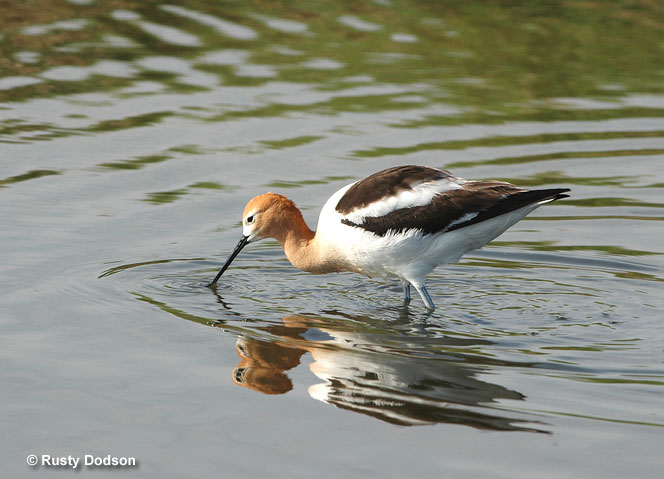
The origin of bird names can be a fascinating insight into the history of the bird.
Bird names started to become more important as people traveled and discovered more and more different species. But what were they named after and how closely related are their names and scientific names?
- How Do Birds Get Their Names?
- 1. American Avocet | The scientific name is Recurvirostra americana.
- 2. Northern Mockingbird | Scientific name: Mimus Polyglottos
- 3. Wood Stork | Scientific name: Mycteria americana
- 4. Blue Jay | Scientific name: Cyanocitta cristata
- 5. Wilson’s Plover | Scientific name: Charadrius wilsonia
- 6. Cactus Wren | Scientific name: Campylorhynchus brunneicapillus
Here are six birds with interesting names, either common or scientific.
How Do Birds Get Their Names?
Bird names are everchanging. Most stay the same, but in recent years, many species have been renamed (and some are yet to be renamed). Let’s take Canada Jay, for example – this bird was known as the Canada Jay from the 19th century, but in 1957, its name was changed to Gray Jay. However, in 2018, they changed it back to Canada Jay.
Scientific names change from time to time, too. This phenomenon usually happens when classifications are changed or divided into different subspecies. There are even some cases when two species have been moved together into one species. Similarly, many species have regional differences but are considered to be one overall species.
However, the history of bird names is old – for thousands of years, they’ve had some kinds of names and have symbolized different things to folks who saw them.
It wasn’t until the 18th and 19th century that birds started to get their official names.
Most bird names are derived from one or more of the following characteristics.
- Names from other languages
- Based on its call or song
- Descriptive of the bird’s structure
- Refers to its habitat
- Referring to its color
- Refers to actions or habits
- Refers to food
- Named after a person
- From its geographic locality
1. American Avocet | The scientific name is Recurvirostra americana.
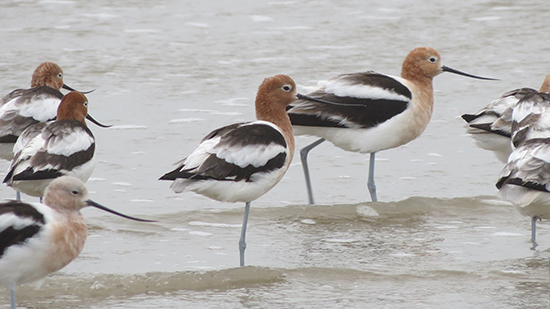
American Avocet is a shoreline bird with long legs and a curved bill. They are found in shallow wetlands and mudflats throughout North America.
American: There are 4 species of avocets. This one is found in America.
Avocet: From French and Italian: French avocette, from Italian avocetta meaning Graceful Bird.
Recurvi | rostra: Recurvi refers to the curved shape of the bill. Rostra is probably a retracted form of Rostral, which refers to something situated or occurring near the front end of the body, especially in the region of the nose and mouth or Rostrum, which is a beaklike projection, especially a stiff snout. Often associated with an insect or crustacean but in this case to the bill of a bird.
Americana: Americana refers to America, namely North America, where American Avocets mainly live.
2. Northern Mockingbird | Scientific name: Mimus Polyglottos
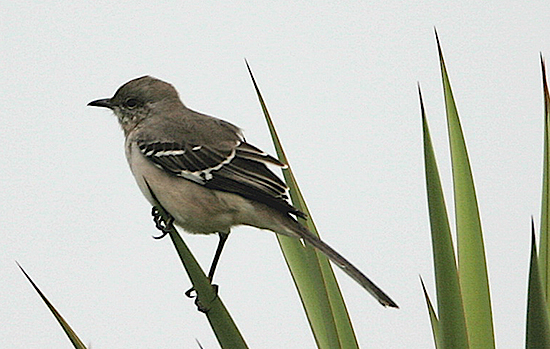
Northern Mockingbirds are common across the United States, so there’s a good chance you’ve crossed paths with one. What makes these creatures so special, is their amazing mimicking power.
These birds can imitate other birds, animal sounds, and even some human-specific notes. They can learn hundreds of different songs during their lives!
Northern Mockingbirds live in inhabited areas, but they like shrubs to take cover. And this is where the ‘mocking’ part of their names comes into play – unless they feel threatened, it can be nearly impossible to identify who you’re hearing.
Northern: There are several species of mockingbirds. Most are found south of the United States, thus the Northern designation of this mockingbird species.
Mockingbird: From its habit of mocking or mimicking the calls of other species.
Mimus: Relating to mimicking the songs of other birds.
Polyglottos: From Polyglot – a person who knows several languages.
3. Wood Stork | Scientific name: Mycteria americana
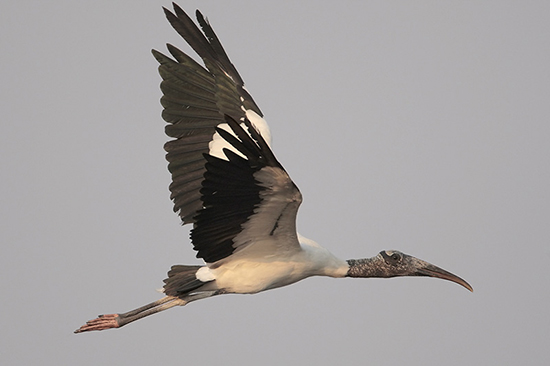
Wood Storks are quite creepy-looking birds, with their unusual heads and long, slightly curved bills. They live near wetlands, where these birds forage in shallow waters, looking for fish, reptiles, and insects.
When it comes to Wood Stork’s name, this is spot on. They have gotten their name from the habit of nesting in trees, and they happen to be the only stork species living in America. Even the Latin name hints at their unusual bill.
Wood: From its habit of nesting in trees.
Stork: From the Old English – storc.
Mycteria: From the Greek mukter, nostril, to sneer, and elephant’s trunk. Reference to the large bill on this bird.
Americana: From its natural range.
4. Blue Jay | Scientific name: Cyanocitta cristata

Blue Jay is a common backyard bird from the Corvidae family, meaning they are directly related to crows and magpies. These birds mostly inhabit the eastern side of North America, but a good portion moves to western areas for breeding season.
Both its common name and scientific name hint at its color and chattering call. Even if you haven’t seen one, just looking at this bird’s name tells you, that it is blue, while Jay hints at its family.
As for the scientific name, it’s interesting to see how accurately this name describes these birds!
Blue: From its blue color.
Jay: From French geai. May be an onomatopoeia reference to its call.
Cyanocitta: A dark blue chattering birds. Greek kuanos – dark blue, kitta – a chattering bird.
cristata: From Latin cristatus – with a crest.
5. Wilson’s Plover | Scientific name: Charadrius wilsonia
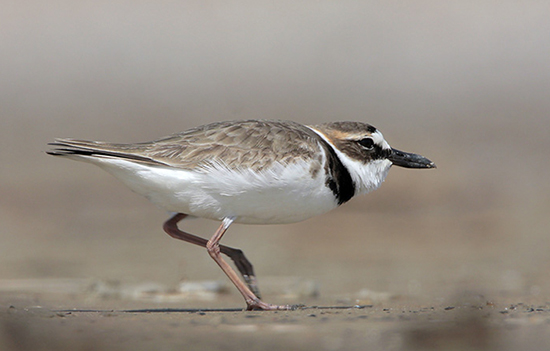
Wilson’s Plover is a medium-sized shoreline bird. As far as shoreline birds go, this species is quite small – these kinds of birds generally forage in the water too, so they have longer legs and bills. This bird, however, forage on beaches.
Although their name does not sound too weird, they got their name from Alexander Wilson, an American ornithologist, who left huge shoes to fill. The background behind Wilson’s Plower’s scientific name is just as interesting.
Wilson’s: Named for Alexander Wilson (1766-1813), known as the father of American ornithology.
Plover: From the Latin pulvia for rain. No one seems to know why this was chosen.
Charadrius: From Greek kharadrios – a yellow bird dwelling in clefts. Not necessarily the bits fit for this bird that is neither yellow nor does it make a habit of nesting in ravines, gullies or clefts. It nests on a bare scrape on sandy beaches or sandbars.
Wilsonia: Another reference to Alexander Wilson
Can you think of another bird named for Wilson?
6. Cactus Wren | Scientific name: Campylorhynchus brunneicapillus
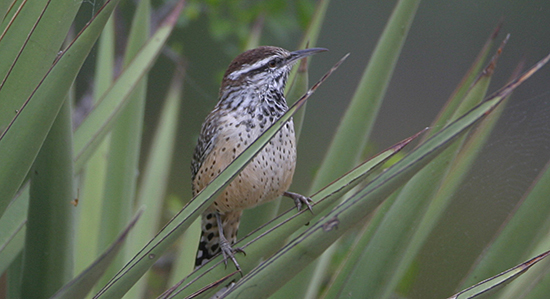
The Cactus Wren is part of the Wren family, known to live in arid environments. These birds have beautiful spotted plumage, along with a brown cap and sharp bill.
It’s safe to assume Cactus Wrens got their name from their habit of nesting in cactus plants. However, their Latin name is much more complicated.
And let’s face it, saying Cactus Wren is much easier than saying its scientific name – Campylorhynchus brunneicapillus.
Cactus Wren’s scientific name is closely tied to their looks. Campylorhynchus hints to their bill, while brunneicapillus is a hint to their brown caps.
Cactus: From its habit of nesting in cacti or other thorny shrubs.
Wren: From the Anglo-Saxon wraenna, their name for this type of bird.
Campylorhynchus: Curved beak. From the Greek kampulos – curved or bent like a bow, and rugkhos, a snout or the beak/bill of a bird.
Brunneicapillus: From Latin brunneus, meaning brown, and capillus, meaning hair of the head. References the brown cap on the bird.
Do you know any other birds with interesting names? Let us know in the comments!

